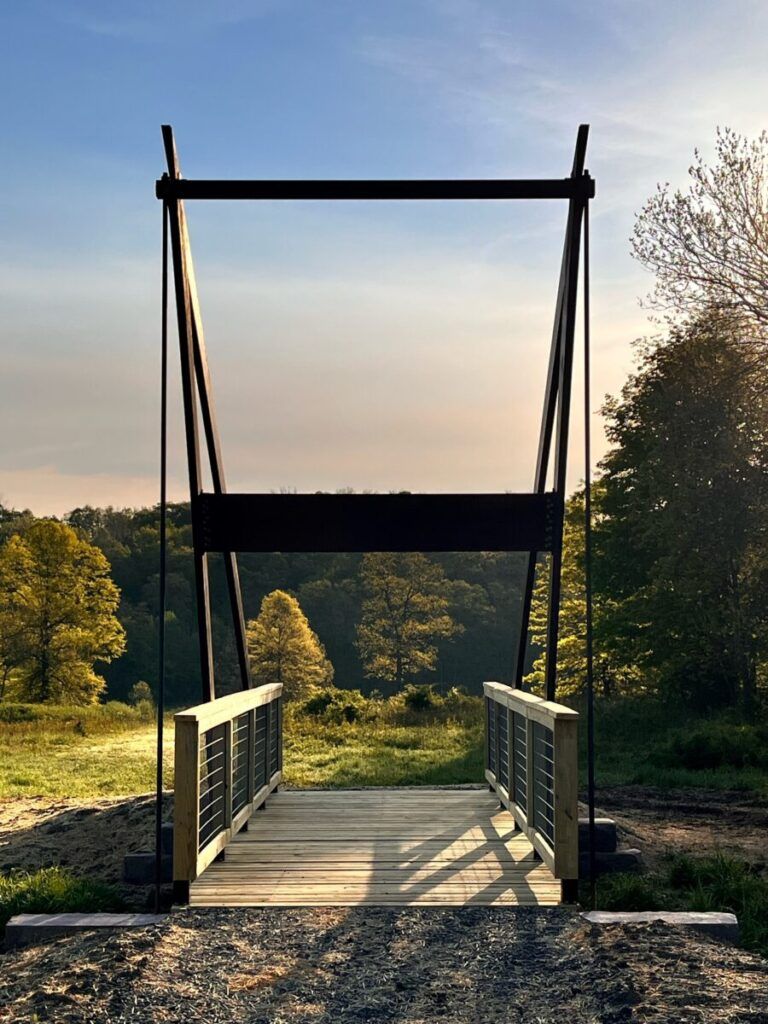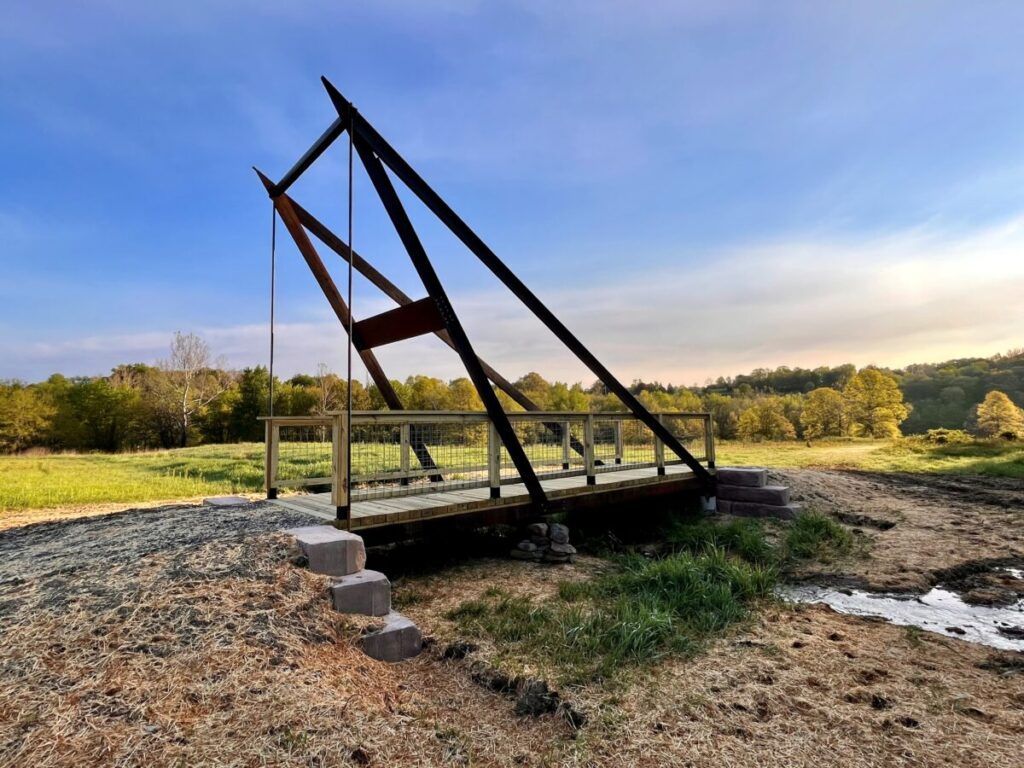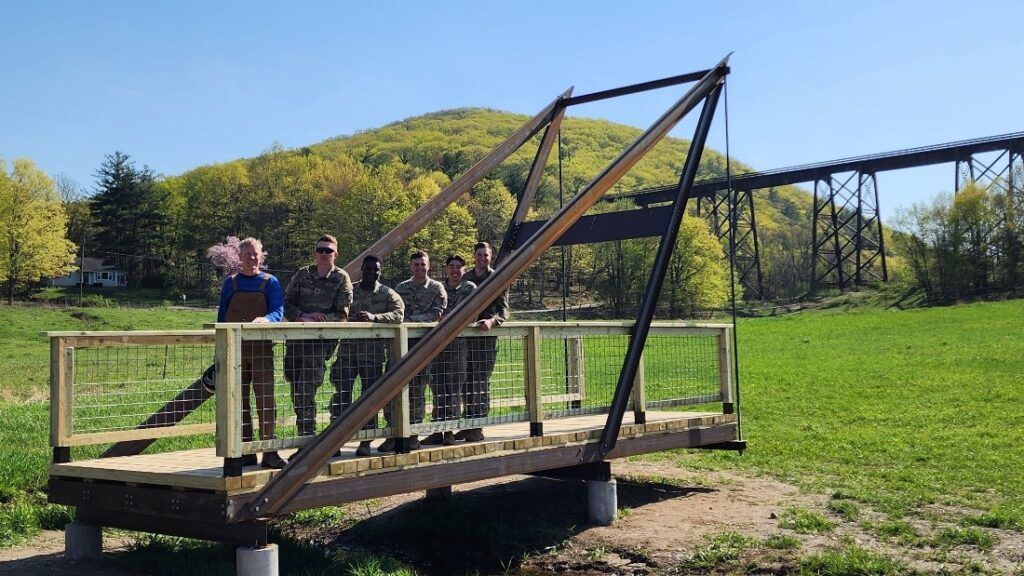Open Space Institute, U.S. Military Academy Engineering Students Construct New Trail Bridge at Schunnemunk State Park
Schunnemunk State Park has a new pedestrian trail bridge, thanks to a collaboration between the Open Space Institute (OSI), the U. S. Military Academy (USMA) at West Point, the New York State Office of Parks, Recreation, and Historic Preservation (OPRHP), and the Palisades Interstate Park Commission (PIPC).
This project marks the sixth year that OSI has worked with the USMA cadets to design and construct a trail bridge at a New York State Park. The bridge was constructed as part of a senior-year capstone project by cadets, who receive hands-on design and construction experience as they pursue degrees in Civil Engineering and train for their military careers.
The new bridge spans an agricultural drainage ditch, allowing trail users to safely cross when seasonally wet and muddy conditions are present without causing landscape erosion or damage, in an area of the park known as Schunnemunk Meadows. The project will support year-round, multi-use recreational access on the future Schunnemunk Meadows trail, including hiking, walking, running, cycling, cross-country skiing, and snowshoeing.
Located within the viewshed of the historic Moodna Viaduct, Schunnemunk Meadows was permanently protected by OSI in 2015, and transferred to OPRHP in 2018 as an addition to Schunnemunk State Park, with OSI managing the land through 2028. Over the past two decades, OSI has protected more than 3,300 acres to create and expand Schunnemunk State Park, for public benefit and enjoyment.

“We are thrilled to support the cadets in enhancing Schunnemunk State Park, a landscape OSI has worked to create, expand, and improve for more than 20 years,” said Peter Karis, OSI’s vice president of parks and stewardship. “We value our relationship with West Point. Parks benefit from the active involvement and participation of our future Army leaders. It is extremely gratifying to work with dedicated students at this formative part of their education and the start of their careers.”
State Parks Commissioner Erik Kulleseid said, “State Parks is proud of this collaboration at Schunnemunk State Park – for how it was designed and constructed and how it will aid visitors in Schunnemunk Meadows. It’s a perfect example of both identifying and solving a problem that makes safety a top priority. We commend OSI, PIPC and thank West Point cadets for honoring New York State with their expertise.”
Professor Led Klosky, who advised the cadet team along with Lt. Col. Adrian Biggerstaff and Dr. Gary Jordan, was very pleased with the outcome of the project, “These bridge projects provide a unique opportunity to train cadets in design, construction, project management, and team building, essential skills for an officer in the U.S. Army, while at the same time challenging them with building in remote conditions. This year’s team can be really proud of what they’ve accomplished; the Schunnemunk Meadow Bridge is beautiful, functional, and will last for many years to come.”
Cadet Alex Cummings, a member of the bridge team, was deeply impacted by the work, “Designing and building this bridge alongside my peers with the mentorship of our advisors has been one of the most fulfilling experiences of my cadet career. Our team was able to apply multiple aspects of our Civil Engineering education to solve a real-world problem and develop a landmark for the local community that complements the natural beauty of the surrounding landscape. I look forward to hiking the Schunnemunk Meadows Trail and visiting the bridge our team built in the coming years.”
Each bridge built by cadets has a distinct style reflecting the needs of the terrain and the design process of the cadets in collaboration with project collaborators. This year, the cadets designed and constructed a 26-foot-long steel cantilevered suspension bridge inspired by the striking Moodna Viaduct and the adjacent Schunnemunk Mountain. The bridge’s asymmetrical design also incorporates a prominent “A” for “Army” into the upright superstructure, while honoring elements of the monumental sculptures at nearby Storm King Art Center.
With private support, OSI was able to provide more than $15,000 for bridge materials and site preparation. OSI also led the process to obtain environmental clearances from state agencies, including an archaeological investigation and noise impact assessment for bald eagles as part of the project’s review. In total, OSI has contributed more than $65,000 in support for these pedestrian bridges over the past six years.

PIPC supplied additional onsite coordination and equipment, and Schunnemunk State Park staff assisted with transportation of materials.
OSI’s Karis added, “This is an amazing relationship with real outcomes that the public can feel good about. Each project produces something special and unique, and each class of cadets is creating a legacy that improves New York’s state parks for everyone.”
This year, after seeing the cadets’ impressive engineering work firsthand, John Bernauer, President of Industrial Services Enterprises, donated $9,000 worth of steel for the Schunnemunk Meadows bridge project.
“I was happy to help the Cadets with their Capstone Project of designing, engineering, and fabricating the Schunnemunk Meadows Bridge. It is always important to give back to the community,” John Bernauer said. “With the cadet’s engineering design and drawings along with my resources through work, I was able to help the cadets secure material, assist in the fabrication of the raw steel, and deliver the material to the project site. The cadets finished the fabrication and erected the bridge by hand and did a great job.”
The project was also supported by a $15,000 grant from the Orange County Soil and Water Conservation District (OCSWCD).
Kevin Sumner, OCSWCD’s conservation district manager said, “OCSWCD was pleased that New York State Department of Environmental Conservation (NYSDEC) entrusted us with the administration of Environmental Benefit Project funds. The Orange County Land Trust and the Moodna Creek Watershed Intermunicipal Council helped us identify projects that would benefit the Moodna Watershed. The Schunnemunk Meadows Cadet Bridge was a great choice for use of this funding.”

The Schunnemunk Meadows bridge project is part of a larger effort led by OSI to build a formal shared-use trail network in the area. After decades of OSI’s work to create and expand the Schunnemunk State Park, OSI is partnering with OPRHP to build a gentle 2.4-mile loop trail through Schunnemunk Meadows that will connect the Otterkill Road Trailhead to the future Schunnemunk Rail Trail.
The overall cost of OSI’s efforts to bring the primary segments of the Schunnemunk Meadows Trail as well extensive improvements to the Otterkill Road Trailhead to fruition are approximately $1.8 million, launched with leadership support from Lucy Waletzky. Earlier this year, OSI was awarded a $500,000 New York State Environmental Protection Fund challenge grant. The organization has launched a campaign to raise the remaining $400,000.
The vision to create the Schunnemunk Meadows Trail was outlined as a top priority project in OSI’s Highlands West Trail Connectivity Plan, an OSI-created plan which establishes a vision for an interconnected trail system spanning more than 93,000 acres of protected land in the region.
The Schunnemunk Meadows Trail will expand recreational opportunities for the public and further establish Schunnemunk State Park as a destination easily accessible from the New York metropolitan area. The Schunnemunk Meadows Trail project is anticipated to be completed by fall 2025.
OSI’s ongoing connection with West Point has yielded six trail bridges. Previous projects have been completed at Harriman State Park, and four bridge replacements were completed along the School Mountain Road section of the Hubbard Perkins Loop Trail at Fahnestock State Park.
source https://csengineermag.com/open-space-institute-u-s-military-academy-engineering-students-construct-new-trail-bridge-at-schunnemunk-state-park/
تعليقات
إرسال تعليق